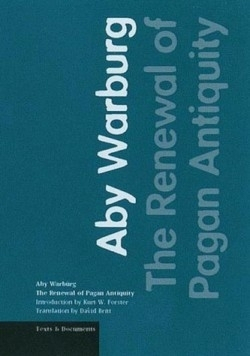The Renewal of Pagan Antiquity
This first complete English translation of thirty-two of Aby Warburg’s essays, papers and notes is much needed. Fully illustrated, extensively annotated and indexed, this finely designed and well-printed volume will earn both readership and praise. Though long admired by art historians as a perceptive researcher of the history underlying classical image and Renaissance representation, Aby Warburg (1866-1929) has not been a household name among the gallery-visiting public. Ironically, his magnificent library, now expanded into the world-famous Warburg Institute of London University, has long overshadowed its founding father.
As eldest son, Warburg was heir to the family’s Hamburg-based bank. At thirteen, wishing to have Mammon serve Art, he traded his inheritance for an assured and well-financed life of book-buying and scholarship. In an ever-widening enquiry he addressed the use of classical iconography and themes in Renaissance art. His starting point was the transition from Gothic to Classical art forms in the Florentine Quattrocento—and he ranged ever more widely through the subsequent artistic developments in Renaissance Europe. The key to his focus lies in the title this volume bears: no simple “return to” but the complex “renewal of” pagan antiquity in art. Warburg saw the artistic world of Renaissance Italy as his great predecessor Jacob Burckhardt had seen it: “coloured in a thousand ways by the influence of the ancient world.” Warburg devoted his working life to teasing out these “thousand ways,” these multitudinous threads of influence, tracing and analyzing how through transforming and reworking classical themes and iconography they shaped the new but related pictorial and artistic representations and forms.
Botticelli’s great mythological paintings, The Birth of Venus and Primavera provided Warburg with his starting point and first field of inquiry. He emphasized that nothing at all in the depiction of deities, nymphs and draperies could be seen as accidental or arbitrary. In analyzing the expressiveness of flowing drapery and the role of gesture in these and other paintings, Warburg interpreted values and meanings significantly changed since antiquity though not divorced from classical roots and texts. He demonstrated forcefully that the transforming forces in art included not only the education, temperament and politics of patrons and painters but considerations of power and responsibility, fortune and fate, as well the
persistence of astrological, superstitious and religious beliefs.
Warburg’s many topics of enquiry reflect an exuberant eclecticism. His essay on Francesco Sassetti’s Last Injunctions to His Son is particularly illuminating in exploring the “psychology of an educated layman in Renaissance Florence” as he ponders the rise and fall of his family, known for its antichità e nobiltà and memorialized in commissioned altarpiece paintings that projected both power and achievement. Warburg did not confine himself to Florence or Italy; he ventured far north of the Alps. The essays variously address exchanges between Florentine and Flemish culture, antiquity and modern life in Renaissance pageantry, and Italian antiquity in Germany. The role of astrology seized Warburg’s critical mind and his far-ranging, late-life 100-page essay, Pagan-Antique Prophecy in Words and Images in the Age of Luther, shows how intensively he explored the topic. Warburg was no desk-bound scholar; early in his career, in order to investigate religious imagery and its evolution in a non-European environment, he visited Hopi encampments in Arizona, accumulating a valuable photo archive.
Warburg’s search for the catalysts in the transmission of culture, for discontinuities and disruptions in transitions, and related explanatory information led him to often hitherto unexamined archives and memoirs as well as to such byways as family crests and seals, theater scenery designs and costumes, prints, pageant-related art—all reflecting the individual’s or community’s sense of self and role in a world regaining the past while being thrust into an unpredictable future. Though his work on Botticelli remains a major contribution, Warburg’s work in other areas of research seldom formed structured wholes. This is no loss; their value lies in their breadth and
the labyrinthine but well-marked avenues of inquiry he opened. He was not a practitioner of the tidier, more formal art-historian scholarship of Wöfflin, Panofsky or Gombrich but was more the brilliant and engaging amateur, in the best sense of that often abused word. His never-completed Mnemosyne Atlas (a hugely ambitious compilation of images and notes illustrating the transmission of cultures) bears witness to this, as well as to his range of endeavors.
Warburg’s essays, first collected in the original German in 1932, remain important contributions to the study of sign, symbol, source and meaning in Renaissance art. With its richness of cross-reference and documentation, this handsome book is an essential addition to any scholarly library, and one that will be treasured by individual purchasers. Every reader will be in debt to Kurt W. Forster for his valuable introduction and to David Britt for an entirely fluent translation of Warburg’s German, known to be in many passages both dense and difficult.
Reviewed by
Peter Skinner
Disclosure: This article is not an endorsement, but a review. The publisher of this book provided free copies of the book to have their book reviewed by a professional reviewer. No fee was paid by the publisher for this review. Foreword Reviews only recommends books that we love. Foreword Magazine, Inc. is disclosing this in accordance with the Federal Trade Commission’s 16 CFR, Part 255.

